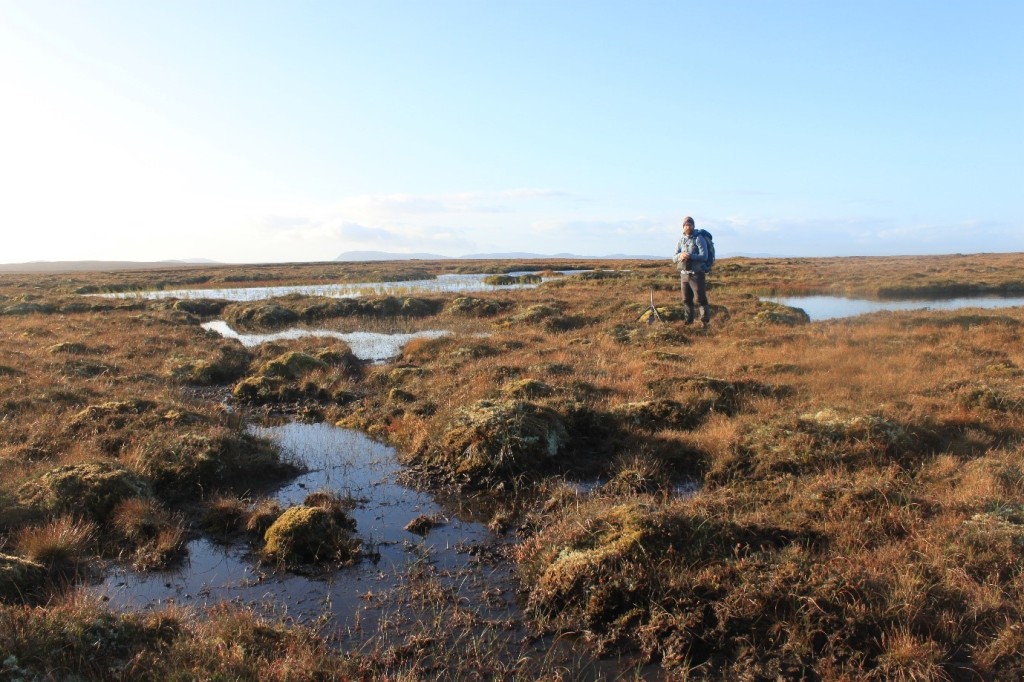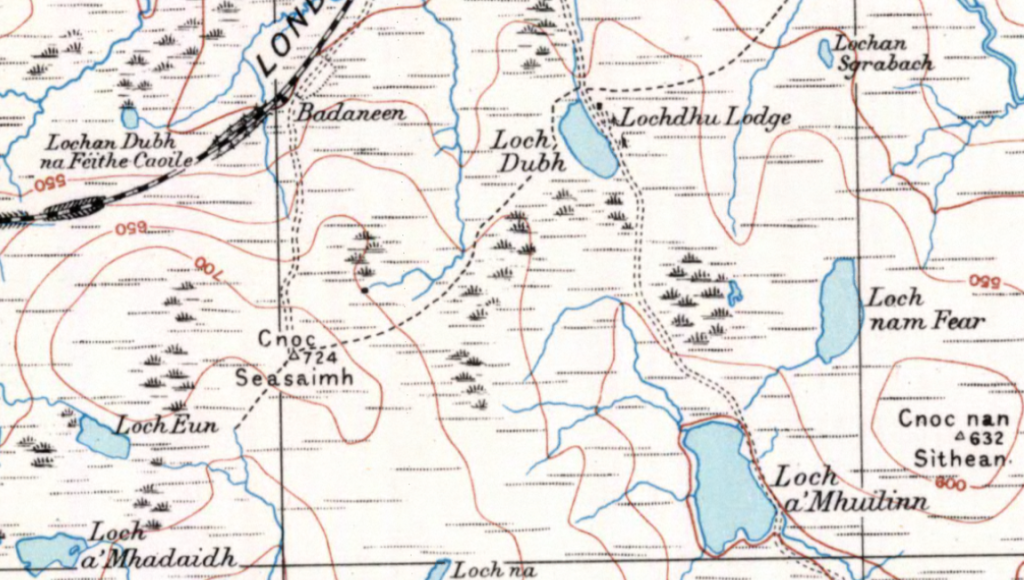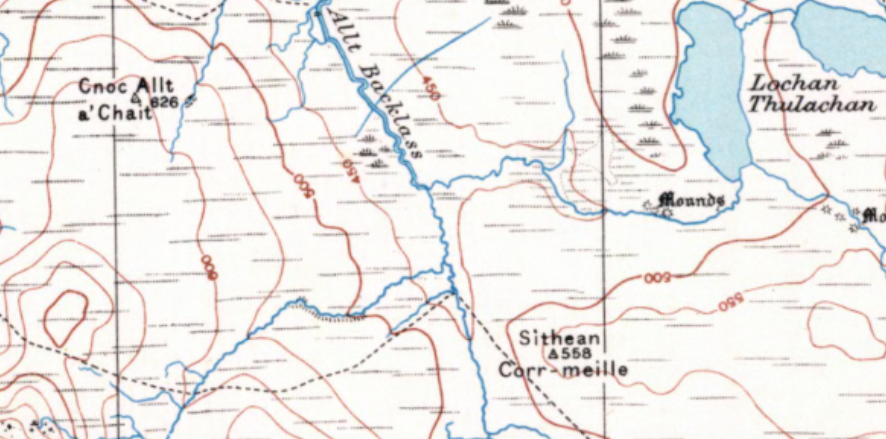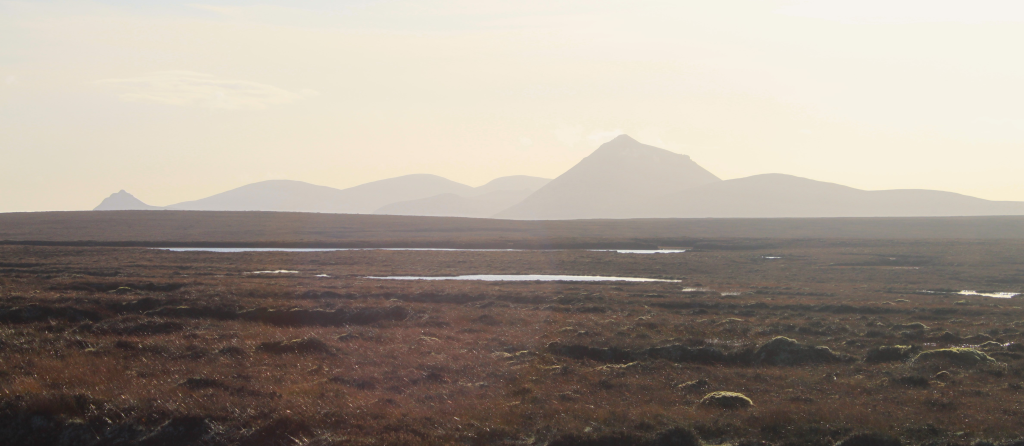As Roddy Maclean explores, the Gaelic language dominates the toponymic landscape of the ‘most intact and extensive blanket bog system in the world’.
Leugh ann an Gàidhlig / Read in Gaelic
You probably know or might have suspected that the Gaelic language has a large vocabulary connected to peat and peatlands. It came to maturity as a vernacular in a landscape which is well endowed with peat, and even has proverbs which relate to peat or peat-cutting (the resource being used as an indigenous fuel for centuries). Blanket bog – the sort that covers large areas of land – is a particular glory of Highland Scotland. Indeed, it might be argued that it is one of the benefits of living in a cool place with plenty of rain!
I’m a fan of areas which have been granted World Heritage status. When I lived in Australia, I was a member of the Tasmanian World Heritage Area Consultative Committee which, in those early days following the attainment of UNESCO World Heritage status for wild and mountainous national parks that covered a fifth of Tasmania (which itself is only slightly smaller than Scotland), advised the State and Federal governments on the management of that precious area. So, do I think that the Flow Country of Caithness and Sutherland – that forms the core of the largest blanket bog in Europe – is worthy of World Heritage status? Yes, I do, and I hope that the steering group that have led the bid will receive good news in mid-2024 when UNESCO are due to pass their judgement on the application.

The Flow Country is special. It is globally significant in the rarity of its assemblage of habitats, flora and fauna, and it has an extent and wildness that make it a special place for the human spirit. It is also, of course, of enormous significance in the struggle against climate change, providing a location where vast amounts of carbon, in the guise of peat, are sequestered. The integrity of the boglands there – now and in the future – can play an important role in our contribution to climatic regulation. I recently walked across a section of the Flow Country, using the railway for access (and avoiding any private vehicle use from home back to home) and was rewarded with a wonderful experience that was inspirational. A windy, sunny morning, wandering among the myriad dubh-lochans on the hill-tops, where following a straight line is an absolute impossibility, with a distant background of the shapely hills of Caithness and Sutherland pleasing the eye, was a total buzz!
The steering group that put forward the bid for World Heritage status are to be commended on their attention to detail. They have nominated seven discrete but mostly adjacent areas, stretching across much of Caithness and Sutherland, and totalling around 200,000 hectares. The area of land covered by the bid might have been even more extensive, but it was decided to exclude significant areas dominated by mineral soil or in-bye land in the straths and also to exclude populated areas (except estates which contain tiny populations, largely consisting of gamekeepers, estate workers and the like).
You will be aware that this is a Gaelic-themed blog, and you might be wondering where it is leading on this occasion. It is to an analysis of the language of the land in the Flow Country. I recently perused the publicly available consultation document produced in the preparation of the nomination bid which presents a substantial and well-argued case. However, as a Gael who has long been keenly aware how strong the presence of Gaelic is in the Flow Country landscape, I must confess to disappointment in the lack of a mention of the language in the document. I am aware that the World Heritage bid is based on the natural values of the region and that, unlike St. Kilda, for example, there is no cultural element in the nomination. But I wondered if an opportunity had been missed. As a Gael, the natural values of the Highland landscape are enhanced by the close and unique relation we have to it through our language and heritage. It’s clearly a message we need to get out more.

The name Flow derives from Old Norse. The Gaelic term for the area is Dùthaich nam Boglaichean ‘the land of the bogs’. But just as the English word bog derives from Gaelic, so the Gaelic language has made its presence felt in both Scots and English, as spoken and written today in Caithness and Sutherland. A significant number of words recorded in the Scots dialect of Caithness, particularly those connected to nature, have an origin in Gaelic, and certain features associated with the Flow Country are named in Gaelic. Examples are the dubh-lochans ‘black pools’ which are formed in peat – the term is even used by English-speaking ecologists – and the area to the west of the Kyle of Tongue which is known as A’ Mhòine ‘the peatland’, anglicised ‘Moine’, and employed in the geological term ‘Moine Thrust’, a tectonic feature that has its northern terminus in A’ Mhòine.
But what of the wider landscape? During my recent walk in the area between the railway stations at Altnabreac (Allt nam Breac ‘the burn of the trout’) in Caithness and Kinbrace (Ceann a’ Bhràist ‘the head of the upland’) in Sutherland, I was impressed by just how strongly Gaelic the landscape is – it seemed that perhaps as many as nine in every ten names were Gaelic. I decided to test the hypothesis that the Flow Country is as Gaelic as most parts of the Gàidhealtachd by looking at the place-names in a sample area. I chose a section of one of the seven component parts of the proposed World Heritage Area which runs from close to Portskerra in the north to near Helmsdale in the south and is known as the ‘East Halladale component’. This was the area in which I was walking.
In the limited time I had available, I looked at place-names on the Ordnance Survey 1:25 000 map in that component, but only south and east of the railway line (which bisects the component) and going as far south as the east-west ‘300’ grid line that runs through Braemore (Am Bràigh Mòr ‘the great upland’), incidentally one of the last Gaelic-speaking communities in Caithness. My treatment of the names was relatively cursory and did not extend to checking early forms, accessing estate maps or speaking to people on the ground, but I hope you will agree that it throws up some interesting statistics.
I recorded 315 toponyms of which 268 are pure Gaelic (85.4% of the total). 18 place names contain a Gaelic element but combined with another linguistic element (Scots, English or Norse) – 5.7% of the total. So, in all, 91.1% of the place-names in my sample contain a Gaelic element, and most of them are pure Gaelic. Only 47 names do not directly demonstrate a Gaelic element, although some may actually be translations of Gaelic originals or demonstrate the presence of a Gaelic cultural heritage. These non-Gaelic names were formed in Norse, Scots or English or a combination of those languages.
In such a well-watered land, it is perhaps no surprise that the default Gaelic word for burn – allt – is extremely common. There are 84 names with allt or alltan (a diminitive of allt), not far short of a quarter of all the sample area’s place-names, but it is not the only element that identifies running water. There are 14 names in fèith – a stream that runs through peatland, sometimes at higher altitudes – and a notable characteristic of country with blanket bog. Examples are Fèith Gaineimh Bheag ‘small sandy bog-stream’ and Fèith Bhuidhe Mhòr ‘large yellow bog-stream’, the colour in the latter being a vegetational descriptor.
In contrast there are only 18 ‘burn’ names (recorded in Scots or English) and several of those are connected with Gaelic elements, examples being Glen Dubh Burn, Cnoc Maol-dhùin Burn and Caplaich Burn (the last referring to a place where horses were kept or grazed). Loop Burn is probably a partial translation of Allt nan Lùb ‘the burn of the bends’ and Black Burn is likely to be a translation of Allt Dubh, of which there are three untranslated examples in the sample area.
Wildlife is named in the toponymy. There is Allt na Greighe ‘the burn of the herd’, likely to be referring to the red deer (which are still plentiful there), Bad a’ Chlamhain ‘the place or thicket of the buzzard’, Blàr nam Faoileag ‘the plain of the gulls’, Creag nan Cat ‘the crag of the wildcats’ and Lùb na h-Eala ‘the river bend of the swan’. Red deer are also name in Allt an Fhèidh ‘the burn of the deer (sing.)’ and Meur nan Ruadhag ‘the branch-stream of the young deer (pl.)’.

Reproduced with the permission of the National Library of Scotland
Then we have the madadh ‘wild dog’ names which can potentially stand for either the fox or the wolf if the specific is not present. As we see the term sionnach ‘fox’ in one local toponym, is it entirely unreasonable to suggest that Cùil a’ Mhadaidh might be ‘the nook of the wolf’? Sutherland is often put forward as one of the places where Scottish wolves made their last stand, and there are half a dozen madadh toponyms in the sample area.
People have also lived in this landscape for a long period, and it is important to remember that, despite its relative wildness, it is not a wilderness. The place-names remind us of this. Some characters are named – as in Alltan Daibhidh ‘David’s small burn’, Alltan Iain Duinn ‘the small burn of brown-haired John’, Allt Iain Ghobha ‘the burn of John the blacksmith’ and Cnoc Thormaid ‘Norman’s hill’. These masculine references are balanced by the English/Scots toponyms Catherine’s Loch and Margaret’s Loch and the Gaelic Gleann nam Bean (presumably dialectal for Gleann nam Ban) which the Ordnance Survey Name Book confirms as meaning “wives’ glen”.
There are ancient religious sites and numerous ruined settlements. Some shielings (settlements used in summer for grazing cattle and making dairy produce) are also named, such as the Àirigh Chruaidh ‘shieling on hard ground’ and Àirigh Meur nan Cabar ‘the shieling of the branch-stream of the poles’. The latter name is fascinating as cabar often refers to woodland where rafter-sized wooden poles could be obtained. More of this at the end!
The people’s livestock are named in several place-names. There is Càrn nam Muc ‘the hill of the pigs’, Allt nam Bò Odhar ‘the burn of the dun cows’, Cnoc nam Bò Riabhach ‘the hill of the brindled cows’, Buailemor (A’ Bhuaile Mhòr ‘the large cattlefold’), Cròc nan Làir ‘the pastureland of the mares’, Cnoc an Eich ‘the hill of the horse’ and references to goats, including Allt Mheann ‘burn of kids’, Meur nan Gobhar ‘the branch stream of the goats’ and Allt a’ Bhuic ‘the burn of the buck’. And the work of milling grain is not forgotten, with three muileann ‘mill’ names near Altnabreac (probably all referring to the same mill).
Folkloric references to some of the great heroic figures of Gaeldom are also present. There is Cnoc Fhinn ‘the hill of Fionn’, anglicised ‘Knockfin’, recalling the famous leader of the Fianna, and Deirdre’s Spring – recorded on the map in English – is linked to one of the best-remembered and most tragic of all the Gaelic heroines, celebrated in both Scotland and Ireland. Further west in the Flow Country, another of the great legendary heroes is remembered for coming to an unfortunate end as he vanquished a wild boar on the slopes of Ben Loyal. Diarmad’s grave – Uaigh Dhiarmaid – is at the base of the mountain (and on the OS map).

Finally, with regard to vegetation and habitat, what do the place-names in my sample area tell us? There are eleven examples of toponyms with the element bad, examples being Bad na Caorach, Bad an Làir and Bad nan Capall, naming sheep and horses. These would lead one to suspect that bad in this part of the country has taken on the general meaning of ‘place’ (irrespective of vegetation) rather than the fairly common meaning in other locations of ‘thicket, clump of trees’. More research would help to elucidate this point; if the meaning is indeed arboreal, it would throw interesting new light on the evidence for trees in this landscape in earlier times. The study area also has one ‘wood’ name (as in a piece of woodland) – Allt Coille ‘wood burn’. The rowan tree ‘caorann’ also occurs in three toponyms in the sample area, although it is impossible to say if each one represents more than a single individual tree. And, as mentioned earlier, there is Àirigh Meur nan Cabar, which name suggests the possible presence in at least one location of sizeable trees. If that is the case, were these natural or planted?
A study of the toponymy of the area can surely only be of benefit to those seeking to understand the Flow Country. If my small sample zone, which is around one-ninth of the entire bid area, has thrown up some interesting information (and I would submit that it has), then a study of the entire area, taking in much more information from old maps, papers and manuscripts would be invaluable.
I wish the bid well. There are currently no World Heritage sites on UNESCO’s list that are designated primarily for their peatlands, and that has to be in the Flow Country’s favour. But I hope that, if the nomination is successful and as the site is developed in the future, due cognisance will be paid to the interactions between humans and landscape that have led to the area being worthy of such a prestigious status; a full and in-depth survey of the toponymic heritage of the area would be part of that. In fact, to be honest, there is no reason to wait for UNESCO. Whether or not the bid succeeds, Scotland would benefit from a greater understanding of the Gaelic landscape and its heritage, particularly as it relates to this outstanding area. It would be nice to see the authorities who are involved in the bid take this on board and perhaps get that particular ball rolling in the near future.
This blog was written by Inverness-based writer and broadcaster Roddy (Ruairidh) Maclean, whose work highlights the connections between the Gaelic language and Scotland’s environment.

You must be logged in to post a comment.